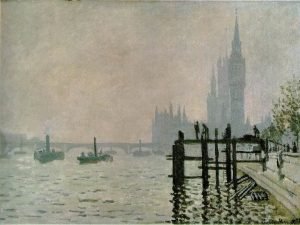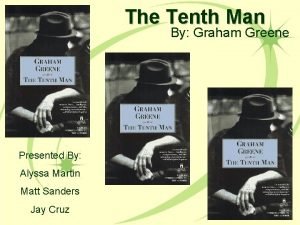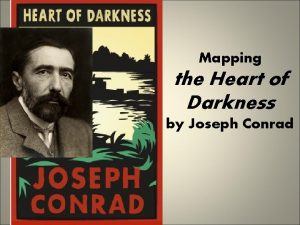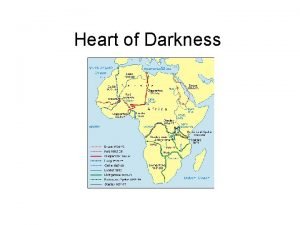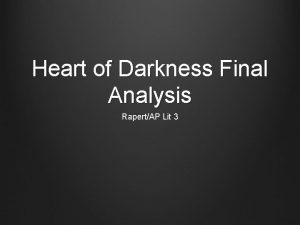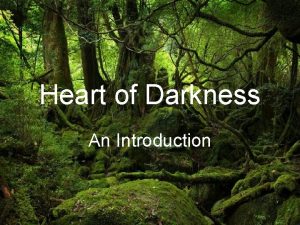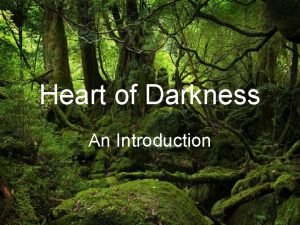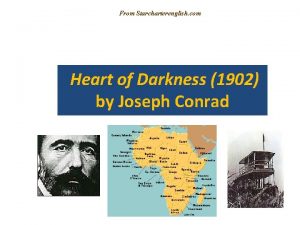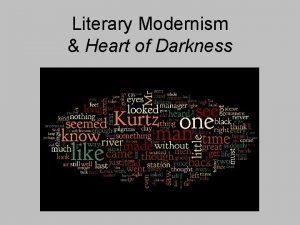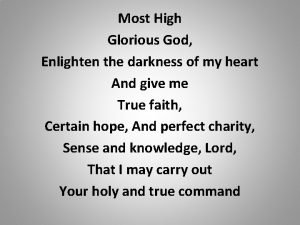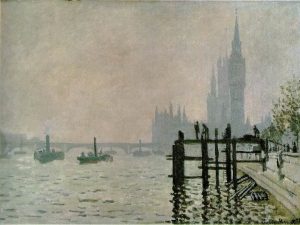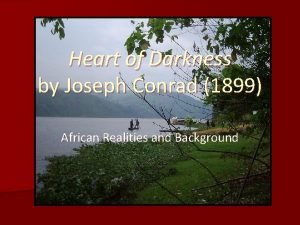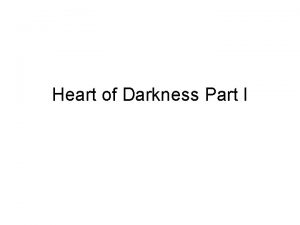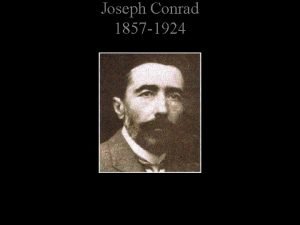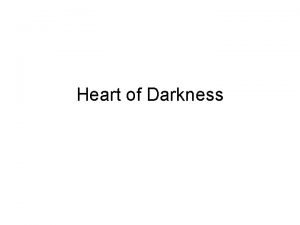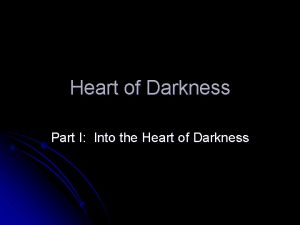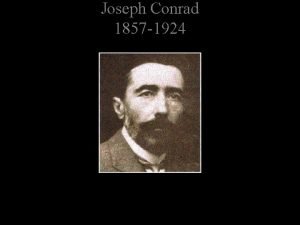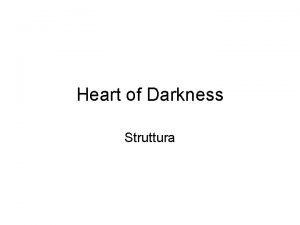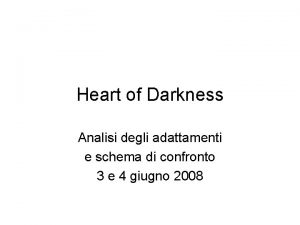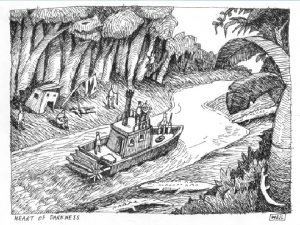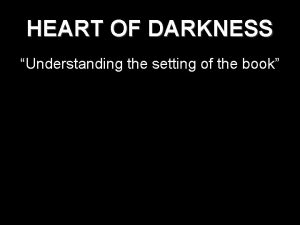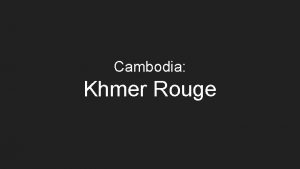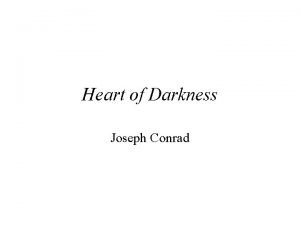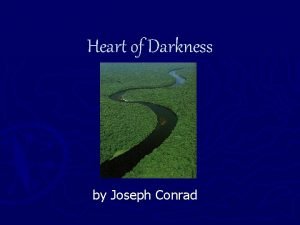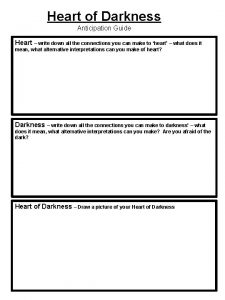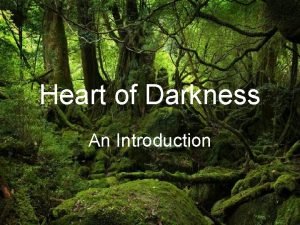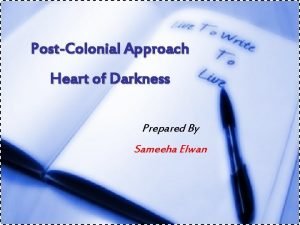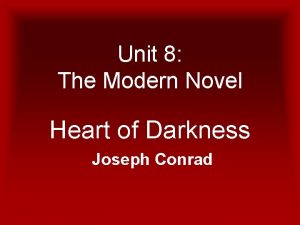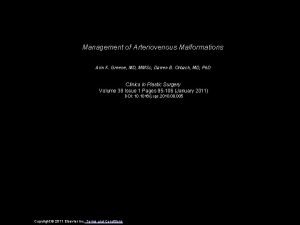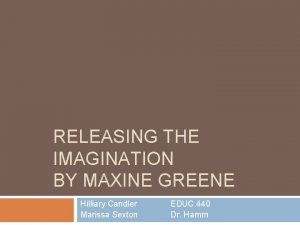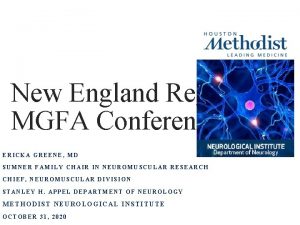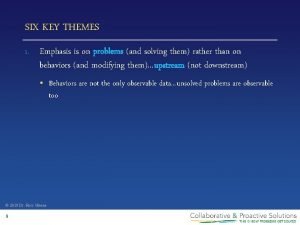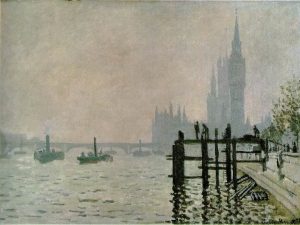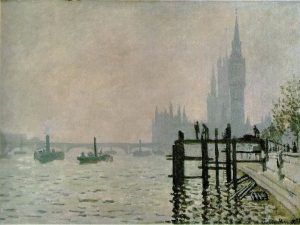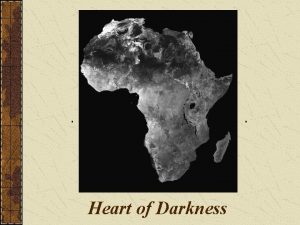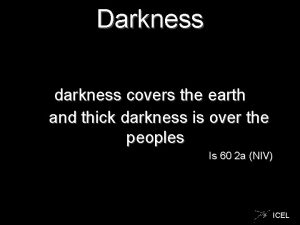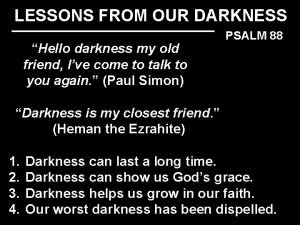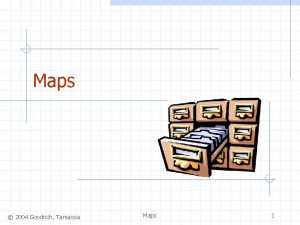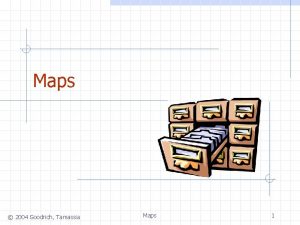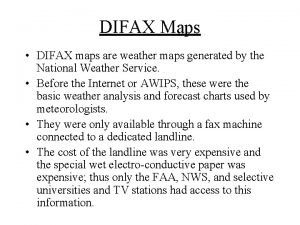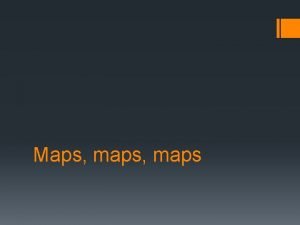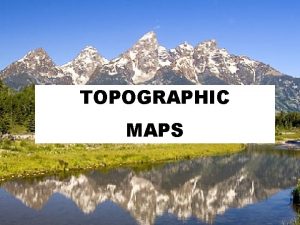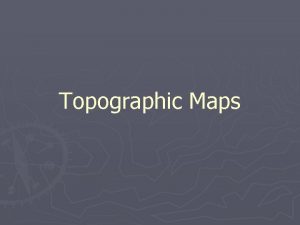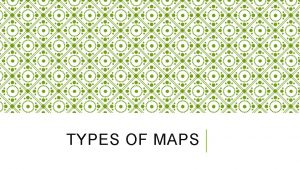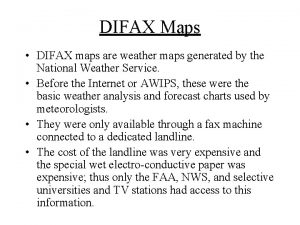Heart of Darkness GRAHAM GREENE Journey without Maps



















































- Slides: 51


Heart of Darkness

GRAHAM GREENE, Journey without Maps (1936) Liberia I thought for some reason even then of Africa, not a particular place, but a shape, a strangeness, a wanting to know. The unconscious mind is often sentimental; I have written ‘a shape’, and the shape, of course, is roughly that of the human heart. Africa will always be the Africa of the Victorian atlas, the blank unexplored continent the shape of the human heart.

Factual/Historical Viewpoint The Congo River was discovered by Europeans in 1482 • No one traveled more than 200 miles upstream until 1877 • Is 1, 600 miles long and only impassable to water traffic between two places, creating a two-hundred mile overland trip s Matadi (the Company Station) s Kinshasa (the Central Station)

History of the Congo 1878 – King Leopold II of Belgium asked explorer Henry Morton Stanley to set up a Belgian colony in the Congo Wanted to “end slavery and civilize the natives” Actually interested in more material benefits 1885 – Congress of Berlin forms Congo Free State This was ruled by Leopold II alone The Congress of Berlin is referred to in the book as “the International Society for the Suppression of Savage Customs. ” Leopold never even visited the Congo. He set up “the Company” to run it for him.

CONGO FREE STATE (1885) 1879 -1885 Henry Morton Stanley explores the region for Leopold II of Belgium 1890 Conrad’s expedition to the Congo (“Before the Congo I was a mere animal”)

Colonial Africa, circa 1892

Democratic Republic of the Congo (1997) The name of this African nation derives from a people known as the Ba. Kongo, first rendered as “Congo” in Portuguese chronicles of exploration in 1482. In their language, the 2, 900 -mile-long Congo River is called nzadi, “the river that swallows all rivers. ”

King Leopold II (reigned 1865 – 1909) Belgian exploitation of the Congo initially focused on the rubber industry.

King Leopold and the Congo Belgium, as a small country, did not possess numerous overseas colonies, unlike its neighbours, Holland, France, Germany, and Great Britain, but shared their imperial ambitions. Leopold persuaded other European powers at the Berlin Conference of 1884 -85 to give him personal possession of the Congo. In 1876 he organized an international association as a front for his private plan to “develop” central Africa. Leopold used the Congo as a huge money-making resource, committing human rights violations in the process, as he built public works projects in Belgium with the money he accrued. 10

Belgium’s Stranglehold on the Congo

5 -8 Million Victims (50% of Population) “It is blood-curdling to see them (the soldiers) returning with the hands of the slain, and to find the hands of young children amongst the bigger ones evidencing their bravery. . . The rubber from this district has cost hundreds of lives, and the scenes I have witnessed, while unable to help the oppressed, have been almost enough to make me wish I were dead. . . This rubber traffic is steeped in blood, and if the natives were to rise and sweep every white person on the Upper Congo into eternity, there would still be left a fearful balance to their credit. ” -- Belgian Official

White King, Red Rubber, Black Death Countries such as France, the Netherlands, and Great Britain that acquired large empires exploited both land people. However… Some measures to protect the rights of overseas subjects were introduced. Rights of women and men to vote. Protection against industrial exploitation was making child labour illegal and improving employment conditions. Some of these rights were followed in the African colonies…. . but NOT BY LEOPOLD II Leopold had to give up the Congo to Belgium in 1908 as a result of the international campaign exposing Leopold’s activities in the Congo.

King Leopold’s Ghost Novel by Adam Hochschild written in 1998 Tells the horrific story of King Leopold’s colonial rule over a country and it’s native peoples. Based on the true story of the colonial activities. King Leopold II, never set foot in the Congo, but managed to ruin a country…his ghost remains today in memories of the Congolese. 14

The Explorer Stanley’s Role H. M. Stanley, a journalist who explored the Congo on an expedition financed by King Leopold of Belgium. Stanley greatly aided his backer in gaining a firm foothold in what was to become the Belgian Congo (later Zaire), now the Democratic Republic of Congo.

“The White Man’s Burden”* “King Leopold found the Congo…cursed by cannibalism, savagery, and despair; and he has been trying with patience, which I can never sufficiently admire, to relieve it of its horrors, rescue it from its oppressors, and save it from perdition. ” --H. M. Stanley *The idea that Europeans must carry the burden of civilizing Africa. 16

Different Motives of Imperialism Some Westerners felt it was their duty to “civilize” the “savage” inhabitant of colonial lands in order to make them more “modern” and European. The English writer Rudyard Kipling displayed such an attitude in 1899 with a poem entitle “The White Man’s Burden. ” Take up the White Man’s burden-Send forth the best ye breed-Go bind your sons to exile To serve your captives’ need; To wait in heavy harness, On fluttered folk and wild-Your new-caught, sullen peoples, Half-devil and half-child. 17

Ivory and “the White Man’s Burden” Most Europeans in the 1890 s felt that the African peoples needed exposure to European culture and technology to become more evolved. This responsibility was known as “the white man’s burden” and the fervor to bring Christianity and commerce to Africa grew. In return for these “benefits, ” the Europeans extracted HUGE amounts of ivory.

Ivory, cont. Uses of ivory in the 1890 s Jewelry and other decorative items Piano keys Billiard balls From 1888 to 1892, the amount of ivory exported from the Congo rose from 13, 000 pounds to more than a quarter million pounds. 1892 – Leopold declares all natural resources in the Congo are his sole property This gave the Belgians free reign to take whatever they wanted however they wished. Trade expands, new stations are established farther and farther away

The Results of Ivory Fever Documented atrocities committed by the Belgian ivory traders include the severing of hands and heads. Reports of this, combined with Conrad’s portrayal of the system in Heart of Darkness, led to an international protest movement against Belgium’s presence in Africa Leopold outlawed these practices, but his decree had little effect Belgian parliament finally took control away from the king Belgium did not grant independence to the Congo until 1960

Joseph Conrad’s Life Born Josef Teodore Konrad Nalecz Korzeniowski, in Podolia, Ukraine, 3 December 1857. Conrad’s father and mother, Apollo and Ewa, were political activists. They were imprisoned 7 months and eventually deported to Vologda. Apollo introduced his son to the work of Dickens, Fenimore Cooper and Captain Marryat in Polish and French translations.

Joseph Conrad’s Life His father died of tuberculosis and his funeral was attended by a thousand admirers Conrad was raised by his uncle; attended school (he was disobedient) Uncle was an aristocrat Cultural background was Western; was taught primarily in French In 1874, Conrad went to Marseilles, France, and joined the Merchant Navy. Smuggling guns for the Spanish and a love affair led to a suicide attempt. Conrad became a British merchant sailor (switched from the French navy) and eventually a master mariner and citizen in 1886. His ten years in the British Merchant Marine shaped most of his stories.

Joseph Conrad’s Life Wrote in a language that was not native to him English was his fourth language Taught himself

Joseph Conrad’s Life Conrad traveled widely in the east. After 15 -20 years, Conrad rose from the lowest rank of to become captain He took on a stint as a steamer captain (1890) in the Congo, but became ill within three months and had to leave. Conrad retired from sailing and took up writing full time. Died of a heart attack in 1924. Buried in Canterbury Cathedral.

Joseph Conrad in response to the rumor that he hesitated between French and English when he started writing “ English was for me neither a matter of choice nor adoption…there was adoption; but it was I who was adopted by the genius of the language…its very idioms…had a direct action on my temperament and fashioned my still plastic characters. ” (Conrad)

Heart of Darkness First published as a serial in London’s Blackwood Magazine in 1899 First unified publication in 1902 Considered by many to be the finest short novel ever written in English Bridges the Victorian and Modern literary periods Modern criticism sharply divided over merit due to racist/imperialist themes

Victorian and Modern Literature Victorian (1837 – 1901) Traditional subject matter, form, and style Deals with issues of the day, including • Social, economic, religious, and intellectual issues • Industrial Revolution • Class tensions, early feminist movement, pressures for social and political reform • Impact of Darwin’s theories on evolution Modern (post WWI – WWII) Authors experiment with subject matter, form, and style Deals with issues of the day, including • • Horrors of WWI Massive loss of life Loss of faith Expanding technology and science • Also encompassed/is related to Postmodernism

Heart of Darkness Background After a long stint in the east had come to an end, Conrad was having trouble finding a new position. With the help of a relative in Brussels he got the position as captain of a steamer for a Belgian trading company. Conrad had always dreamed of sailing the Congo He had to leave early for the job, as the previous captain was killed in a trivial quarrel

Heart of Darkness Background Conrad saw some of the most shocking and depraved examples of human corruption he’d ever witnessed. He was disgusted by the ill treatment of the natives, the scrabble for loot, the terrible heat and the lack of water. He saw human skeletons of bodies left to rot - many were men from the chain gangs building the railroads. He found his ship was damaged. Dysentary was rampant as was malaria; Conrad had to terminate his contract due to illness and never fully recovered

Conrad’s View For Conrad, the world as we experience it is not a sort of place that can be reduced to a set of clear, explicit truths. Its truths—the truths of the psyche, of the human mind and soul—are messy, vague, irrational, suggestive, and dark.

Conrad’s View Conrad’s intention? : to lead his readers to an experience of the “heart of darkness, ”not to shed the light of reason on it…but to recreate his experience of darkness in our feelings, our sensibilities, our own dark and mysterious hearts.

About the Novel Since its publication, Heart of Darkness has fascinated readers and critics, almost all of whom regard the novel as significant because of its use of ambiguity and (in Conrad's own words) "foggishness" to dramatize Marlow's perceptions of the horrors he encounters.

Key Facts Full Title: Heart of Darkness Author: Joseph Conrad Type of Work: Novella (between a novel and a short story in length and scope) Genre: Symbolism, colonial literature, adventure tale, frame story, almost a romance in its insistence on heroism and the supernatural and its preference for the symbolic over the realistic

Key Facts Time and Place Written: England, 1898– 1899; inspired by Conrad’s journey to the Congo in 1890. Date of First Publication: Published in 1902 in the volume Youth: A Narrative; and Two Other Stories. Narrator: There are two narrators: an anonymous passenger on a pleasure ship, who listens to Marlow’s story, and Marlow himself, a middle-aged ship’s captain.

Key Facts Point of View: The first narrator speaks in the first-person plural, on behalf of four other passengers who listen to Marlow’s tale. Marlow narrates his story in the first person, describing only what he witnesses and experiences, and provides his own commentary on the story. Tone: Ambivalent: Marlow is disgusted at the brutality of the Company and horrified by Kurtz’s degeneration, but he claims that any thinking man would be tempted into similar behavior.

Key Facts Setting (time): Latter part of the nineteenth century, probably sometime between 1876 and 1892. Setting (place): Opens on the Thames River outside London, where Marlow is telling the story that makes up Heart of Darkness. Events of the story take place in Brussels, at the Company’s offices, and in the Congo, then a Belgian territory. Protagonist: Charlie Marlow.

Key Facts Major Conflict: Both Marlow and Kurtz confront a conflict between their images of themselves as “civilized” Europeans and the temptation to abandon morality completely once they leave the context of European society. Rising Action: The brutality Marlow witnesses in the Company’s employees, the rumors he hears that Kurtz is a remarkable man, and the numerous examples of Europeans breaking down mentally or physically in the environment of Africa.

Key Facts Climax: Marlow’s discovery, upon reaching the Inner Station, that Kurtz has completely abandoned European morals and norms of behavior. Falling Action: Marlow’s acceptance of responsibility for Kurtz’s legacy, Marlow’s encounters with Company officials and Kurtz’s family and friends, Marlow’s visit to Kurtz’s “Intended. ” Themes: The hypocrisy of imperialism, madness as a result of imperialism, the absurdity of evil.

Heart of Darkness Narrative Structure Framed Narrative Narrator begins Marlow takes over Narrator breaks in occasionally Marlow is Conrad’s alter-ego, he shows up in some of Conrad’s other works including “Youth: A Narrative” and Lord Jim Marlow recounts his tale while he is on a small vessel on the Thames with some drinking buddies who are ex-merchant seamen. As he recounts his story the group sits in an all-encompassing darkness.

Heart of Darkness Motifs Darkness Primitive Impulses (Kurtz, previous captain, etc. ) Cruelty of Man (Kurtz and Company) Immorality/Amorality (Kurtz) Lies/Hypocrisy (Marlow chooses Kurtz’s evil versus Company’s hypocritical evil) Imperialization/Colonization (Belgian Company) Greed / Exploitation of People Power Corrupts Savage vs. Civil

Heart of Darkness Motifs Role of Women Civilization exploitive of women Civilization as a binding and selfperpetuating force Physical connected to Psychological Barriers (fog, thick forest) Rivers (connection to past, parallels time and journey)

Key Facts Motifs: Darkness (very seldom opposed by light), interiors vs. surfaces (kernel/shell, coast/inland, station/forest, etc. ), ironic understatement, hyperbolic language, inability to find words to describe situation adequately, images of ridiculous waste, upriver versus downriver/toward and away from Kurtz/away from and back toward civilization (quest or journey structure).

Contrasts in Heart of Darkness Light vs. Dark Heavy vs. Light Inferiority vs. Superiority Civil vs. Savage Interior vs. Exterior Illusion vs. Truth Misogyny vs. Misanthropy Insanity vs. Sanity Racism vs. Antiracism Imperialism vs. Insularity Evil What makes wellintentioned people do bad things?

Key Facts Symbols: Rivers, fog, women (Kurtz’s Intended, his African mistress), French warship shelling forested coast, grove of death, severed heads on fence posts, Kurtz’s “Report, ” dead helmsman, maps, “whited sepulchre” of Brussels, knitting women in Company offices, man trying to fill bucket with hole in it.

Order in the Midst of Chaos Heart of Darkness’s Structure Three’s: Chapters Marlow breaks off story 3 times Stations Women Central Characters Frame Narrative Light and Dark Transformation


Movie Versions of the Book

Apocalypse Now is a film directed by Francis Ford Coppola starring Martin Sheen, Robert Duvall and Marlon Brando This film was based on Conrad’s Heart of Darkness. Coppola takes the story to Vietnam. Captain Willard (Marlow) is sent on a mission to kill Colonel Kurtz who has gone renegade

Circle of Influence Thomas Pynchon T. S. Eliot Ernest Hemingway F. Scott Fitzgerald William Faulkner Gabriel Garcia Marquez Mario Vargas Llosa Jorge Luis Borges Carlos Fuentes George Orwell Saul Bellow Eugene O’Neill Graham Greene

Joseph Conrad’s Other Works Almayer’s Folly (1895) The Nigger of the Narcissus (1897) Lord Jim (1900) Heart of Darkness (1902) Typhoon (1902) Nostromo (1904) The Secret Sharer (1907) Under Western Eyes (1910) Chance (1914)

Bibliography Power. Point from Sandra Effinger http: //mseffie. com/assignments/heart_of_da rkness/hod. html
 Heart of darkness
Heart of darkness Who wrote the destructors
Who wrote the destructors The tenth man graham greene summary
The tenth man graham greene summary Map of the heart darkness
Map of the heart darkness Without light there is no darkness
Without light there is no darkness Heart of darkness mla citation
Heart of darkness mla citation Heart of darkness map
Heart of darkness map Heart of darkness part 3 quotes
Heart of darkness part 3 quotes Impressionism heart of darkness
Impressionism heart of darkness Heart of darkness as a modern novel
Heart of darkness as a modern novel Heart of darkness theme
Heart of darkness theme Symbols of heart of darkness
Symbols of heart of darkness Modernism in heart of darkness
Modernism in heart of darkness Enlighten the darkness of my heart
Enlighten the darkness of my heart Heart of darkness map
Heart of darkness map Heart of darkness themes
Heart of darkness themes Heart of darkness part 2
Heart of darkness part 2 Heart of darkness slavery quotes
Heart of darkness slavery quotes Heart of darkness summary part 2
Heart of darkness summary part 2 Setting of heart of darkness
Setting of heart of darkness Heart of darkness deaths
Heart of darkness deaths Heart of darkness racism quotes
Heart of darkness racism quotes Tim roth heart of darkness
Tim roth heart of darkness Heart of darkness
Heart of darkness Heart of darkness lesson plans
Heart of darkness lesson plans Setting of heart of darkness
Setting of heart of darkness Heart of darkness cambodia
Heart of darkness cambodia Heart of darkness plot summary
Heart of darkness plot summary Heart of darkness motifs
Heart of darkness motifs Impressionistic writing heart of darkness
Impressionistic writing heart of darkness Heart of darkness shmoop
Heart of darkness shmoop Heart of darkness historical context
Heart of darkness historical context Edward said two visions in heart of darkness
Edward said two visions in heart of darkness Heart of darkness as a modern novel
Heart of darkness as a modern novel Reittihaku google maps
Reittihaku google maps Robin dunkin ucsc
Robin dunkin ucsc Robert greene shakespeare
Robert greene shakespeare Adult expectations
Adult expectations Eric greene course
Eric greene course Kylie greene
Kylie greene Arin greene
Arin greene Maxine greene releasing the imagination
Maxine greene releasing the imagination 7 secrets of the sensitive
7 secrets of the sensitive Green's theorem definition
Green's theorem definition Linda r greene
Linda r greene Ericka greene md
Ericka greene md Uzuri pease-greene
Uzuri pease-greene Linda r greene
Linda r greene Problem solving plan plan b flowchart
Problem solving plan plan b flowchart Patrick mundy
Patrick mundy Why does pablo neruda urge to keep quiet
Why does pablo neruda urge to keep quiet Without title for my father who lived without ceremony
Without title for my father who lived without ceremony
